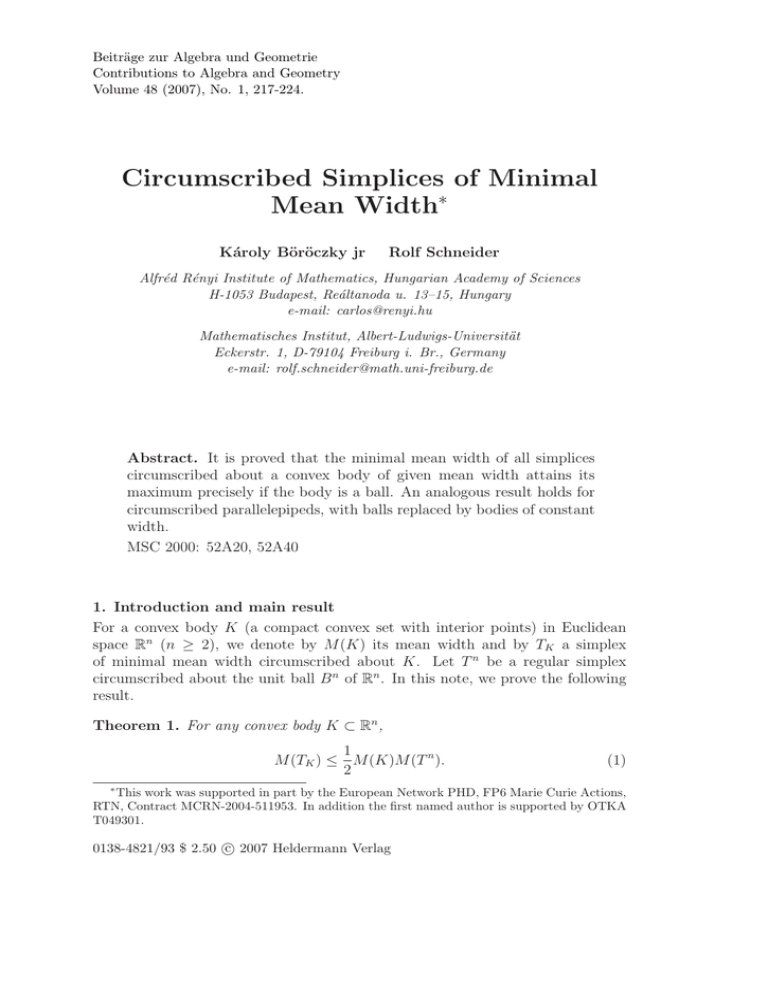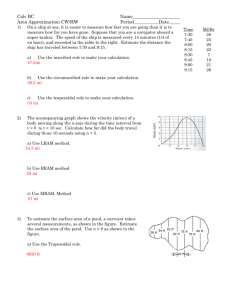Beitr¨ age zur Algebra und Geometrie Contributions to Algebra and Geometry
advertisement

Beiträge zur Algebra und Geometrie
Contributions to Algebra and Geometry
Volume 48 (2007), No. 1, 217-224.
Circumscribed Simplices of Minimal
Mean Width∗
Károly Böröczky jr
Rolf Schneider
Alfréd Rényi Institute of Mathematics, Hungarian Academy of Sciences
H-1053 Budapest, Reáltanoda u. 13–15, Hungary
e-mail: carlos@renyi.hu
Mathematisches Institut, Albert-Ludwigs-Universität
Eckerstr. 1, D-79104 Freiburg i. Br., Germany
e-mail: rolf.schneider@math.uni-freiburg.de
Abstract. It is proved that the minimal mean width of all simplices
circumscribed about a convex body of given mean width attains its
maximum precisely if the body is a ball. An analogous result holds for
circumscribed parallelepipeds, with balls replaced by bodies of constant
width.
MSC 2000: 52A20, 52A40
1. Introduction and main result
For a convex body K (a compact convex set with interior points) in Euclidean
space Rn (n ≥ 2), we denote by M (K) its mean width and by TK a simplex
of minimal mean width circumscribed about K. Let T n be a regular simplex
circumscribed about the unit ball B n of Rn . In this note, we prove the following
result.
Theorem 1. For any convex body K ⊂ Rn ,
1
M (TK ) ≤ M (K)M (T n ).
2
∗
(1)
This work was supported in part by the European Network PHD, FP6 Marie Curie Actions,
RTN, Contract MCRN-2004-511953. In addition the first named author is supported by OTKA
T049301.
c 2007 Heldermann Verlag
0138-4821/93 $ 2.50 218 K. Böröczky jr; R. Schneider: Circumscribed Simplices of Minimal Mean Width
Equality holds if and only if K is a ball.
Every simplex of minimal mean width circumscribed about a given ball is regular.
Remark 1. For n = 2 (where the mean width is the perimeter divided by π),
a more general result is known (see [5]). If Lm (K) denotes the minimum of the
perimeters of all convex m-gons circumscribed about the planar convex body K
and L(K) is the perimeter of K, then
Lm (K) ≤ L(K)
π
m
tan
π
m
for m = 3, 4, . . ., with equality if and only if K is circular; every m-gon of minimal
perimeter circumscribed about a given circle is regular.
√
Remark 2.√The value of M (T n ) for n = 2 is given by 6 3/π = 3.30797 and for
n = 3 by (3 6/π) arccos(−1/3) = 4.4691. From these values, one can obtain the
value for n = 4 by using formula (3) in [7]. Further,
√
M (T n ) ∼ 2 2n ln n
as n tends to infinity, according to a result obtained in [1].
Remark 3. The ‘dual’ analogue of the last part of Theorem 1 is (for n ≥ 3) a
long-standing open problem: among all simplices contained in a given ball, do the
regular ones have maximal mean width? We refer to the discussion in Gritzmann
and Klee [2, Section 9.10.2].
2. Proof of Theorem 1
We fix some notation. We denote the scalar product of Rn by h·, ·i and the
induced norm by k · k. The set S n−1 = {x ∈ Rn : kxk = 1} is the unit sphere,
σ denotes spherical Lebesgue measure on S n−1 , and ωn := σ(S n−1 ) is the total
area of the unit sphere. The support function of a convex body K is defined by
hK (u) := maxx∈K hx, ui for u ∈ S n−1 . The mean width of K is given by
Z
Z
1
2
[hK (u) + hK (−u)] σ(du) =
hK dσ.
M (K) =
ωn S n−1
ωn S n−1
First we deal with the last assertion of Theorem 1. This follows by the same
argument as Hadwiger [3] used it for the isoperimetric quotient. We assume that
T is a simplex circumscribed to the unit ball B n and with minimal mean width.
Suppose T is not regular, then it has vertices v0 , v1 , v2 such that kv2 − v0 k 6=
kv2 − v1 k. Let T 0 arise from Steiner symmetrization of T with respect to the
hyperplane which is the perpendicular bisector of the segment with endpoints v0
and v1 . Then T 0 is a simplex with M (T 0 ) < M (T ) ([3], p. 261, Zusatz IV), and
T 0 clearly contains a unit ball. This is a contradiction, hence T is congruent to
T n.
To prove the first part of Theorem 1, we need the following lemma.
K. Böröczky jr; R. Schneider: Circumscribed Simplices of Minimal Mean Width 219
Lemma. In Rn , let K be a convex body and suppose that T is a regular simplex
circumscribed about K with M (T ) = M (TK ). Then each facet F of T touches K
in the centroid of F .
Proof. Let T satisfy the assumption, and let F be a facet of T . We suppose
that the centroid c of F is not contained in K, and seek a contradiction. We
may assume that the origin o is the vertex of T opposite to F , and that the
vectors v1 , . . . , vn giving the vertices of F are unit vectors. Later we will determine
numbers s1 , . . . , sn ∈ R with the following properties:
P
(i) si < 1 for i = 1, . . . , n, and ni=1 si < 0;
(ii) for all sufficiently small % > 0, the simplex T (%) with vertices o and vi (%) :=
(1 + %si )vi , i = 1, . . . , n, contains K.
Let us assume that (i) and (ii) are satisfied and that % > 0 is so small that
1 + %si > 0 for i = 1, . . . , n. Let Ui (%) denote the spherical image of the vertex
vi (%) of T (%), that is, the intersection of the unit sphere with the normal cone of
T (%) at vi (%). It can be represented by
Ui (%) = {x ∈ S n−1 : hx, vi (%)i ≥ 0 and hx, vi (%) − vj (%)i ≥ 0, j = 1, . . . , n}.
Write Ui := Ui (0) for i = 1, . . . , n. If x ∈ Ui ∩ Uj (%), then
hT (%) (x) − hT (x) = hx, (1 + %sj )vj i − hx, vi i
≤ (1 + %sj )hx, vi i − hx, vi i = %sj hx, vi i.
Below, the implied constants in O(·) depend on n and s1 , . . . , sn . Since σ(Ui ∩
Uj (%)) is a continuously differentiable function of %, we have σ(Ui ∩ Uj (%)) =
O(%) for i 6= j and hence σ(Ui ∆Ui (%)) = O(%), where ∆ denotes the symmetric
difference. Observing that
n Z
n
n Z
2 X
2 XX
hT (%) dσ =
hT (%) dσ,
M (T (%)) =
ωn j=1 Uj (%)
ωn j=1 i=1 Ui ∩Uj (%)
since hT (ρ) = 0 on the spherical
R image of the vertex o (and this spherical image is
independent of %), and that Ui hx, vi i σ(dx) is independent of i, we obtain
2
M (T (%)) − M (T ) ≤
ωn
Z
hx, v1 i σ(dx)
U1
n
X
!
si % + O(%2 ).
i=1
Therefore, if % > 0 is sufficiently small, then M (T (%)) < M (T ), which is a contradiction.
To finish the proof of the lemma, we have to find s1 , . . . , sn satisfying (i) and
(ii). Since c ∈
/ K, we can choose an (n − 2)-dimensional linear subspace L of Rn
such that c + L ⊂ affF and (c + L) ∩ K = ∅. Let u1 , . . . , un ∈ Rn denote the dual
basis
Pn of v1 , . . . , vn ; namely, hui , vj i = 1 if i = j, and hui , vj i = 0 if i 6= j. Then
i=1 ui is orthogonal to affF . We can determine τ1 , . . . , τn ∈ R, not all zero, so
220 K. Böröczky jr; R. Schneider: Circumscribed Simplices of Minimal Mean Width
P
is orthogonal to L and orthogonal to ni=1 vi = nc. In particular,
i=1 τi = 0. Without loss of generality, we suppose that τi < 1 for all i. We may
assume that v1 and v2 are strictly separated by c + L in affF , that v1 and F ∩ K
lie on the same side of c + L, and that τ1 > 0 (hence τ2 < 0).
Let S be any (n − 2)-dimensional affine subspace of affF that does not meet
K. It divides affF into two halfspaces; let w be the unit vector parallel to F and
normal to S that points into the halfspace not containing F ∩ K. The vector z :=
c/kck is the unit normal vector of F pointing away from o. For ϕ ∈ [0, π], let H(ϕ)
denote the hyperplane with normal vector (cos ϕ)z + (sin ϕ)w and containing S.
There is a largest number ϕ(S) ∈ (0, π) such that H(ϕ)∩K = ∅ for 0 < ϕ < ϕ(S).
For δ > 0, we define the δ-neighborhood Nδ of c+L as the set of all subspaces S
as
above
which have distance less than δ from c and for which there exists a vector
Pn
i=1 αi ui orthogonal to S and with |αi − τi | < δ for i = 1, . . . , n. Elementary
continuity and compactness arguments yield the existence of numbers δ0 > 0 and
ϕ0 > 0 such that ϕ(S) ≥ ϕ0 for all S ∈ Nδ0 .
Let 0 < ε < τ1 . For small % > 0, let t%1 := %(τ1 −ε) and t%i := %τi , i = 2, . . . , n.
Let H% be the hyperplane passing through (1 + t%i )vi for i = 1, . . . , n, and let
S% := H% ∩ affF . We put β := ε/(τ1 − τ2 − ε) and suppose that ε is so small that
β < 1. Let
that
P
n
Pn
i=1 τi ui
n
1−β
1X
1+β
(1 + t%1 )v1 +
(1 + t%2 )v2 +
(1 + t%i )vi .
c% :=
n
n
n i=3
Then c% is a convex combinationPof (1 + t%i )vi , i = 1, . . . , n, hence c% ∈ H% .
Moreover, c% − cPis orthogonal to ni=1 ui . It follows that c% ∈ S% .
The vector ni=1 (1 +P
t%i )−1 ui is orthogonal
to H% , hence the difference of u
Pn
n
and this vector, namely i=1 αi ui := i=1 t%i (1 + t%i )−1 ui , is orthogonal to S% .
We can now choose %̃ > 0 so small that for all % ∈ [0, %̃) we have |αi − τi | < δ0 for
i = 1, . . . , n. Next, we can decrease %̃ > 0, if necessary, and choose the number
ε > 0 so small that kc% − ck < δ0 for all % ∈ [0, %̃). With these choices, for
% ∈ [0, %̃) we have S% ∈ Nδ0 and, therefore, ϕ(S% ) ≥ ϕ0 . Again decreasing %̃ > 0,
if necessary, we can achieve that for all % ∈ [0, %̃) the hyperplane H% makes an
angle with the hyperplane H0 = affF which is smaller than ϕ0 . This implies that
H% ∩ K = ∅ and, hence, that K is contained in the convex hull of o and (1 + t%i )vi ,
i = 1, . . . , n. Now we see that the numbers defined by s1 := τ1 − ε and si := τi for
i = 2, . . . , n satisfy (i) and (ii). This concludes the proof of the lemma.
Now we finish the proof of Theorem 1. Let T be a regular simplex, and let
u1 , . . . , un+1 be the exterior unit normal vectors of its facets. Then
n+1
M (T n ) X
M (T ) =
hT (ui ),
n + 1 i=1
n
since this holds if T is circumscribed about
Pn+1 B , and both sides of the equation
are invariant under translations (since i=1 ui = o) and homogeneous of degree
one under positive dilatations.
K. Böröczky jr; R. Schneider: Circumscribed Simplices of Minimal Mean Width 221
Let SOn be the rotation group of Rn , and denote by ν its normalized Haar
measure; then
Z
Z
1
f (ϑu0 ) ν(dϑ) =
f dσ
ωn S n−1
SOn
for any integrable function f on S n−1 and arbitrary u0 ∈ S n−1 .
For ϑ ∈ SOn , let Tϑ be the regular simplex circumscribed about K with
exterior normal vectors ϑu1 , . . . , ϑun+1 . Then
Z
Z
M (Tϑ ) ν(dϑ) =
SOn
SOn
n+1
M (T n ) X
1
hK (ϑui ) ν(dϑ) = M (K)M (T n ).
n + 1 i=1
2
We conclude that M (TK ) ≤ 21 M (K)M (T n ), and equality implies that M (Tϑ ) =
M (TK ) for each ϑ ∈ SOn . In particular, we have proved the inequality (1), and
the last assertion of the theorem shows that equality holds for balls.
To prove uniqueness, let us assume that K is a convex body satisfying M (K) =
M (B n ) = 2 (without loss of generality) and M (TK ) = M (T n ), then M (Tϑ ) =
M (T n ) for any ϑ ∈ SOn . For u ∈ S n−1 , we denote by Hu the supporting hypere u := Hu − n+1 u. For
plane of K with outer unit normal vector u, and we define H
n
given u, let T be a regular simplex circumscribed about K for which u is an exterior normal vector, and F be the corresponding facet of T . We assume, without
loss of generality, that B n is the inball of T . Then u is the centroid of F . By the
lemma, u ∈ K. We assume first that Hu ∩ K = {u}. The centroids of the other
facets of T are also points of K, by the lemma, as well as of B n , and they are
e u . Let ϑ be a rotation fixing u. Let u, u2 , . . . , un+1
contained in the hyperplane H
be the unit normal vectors of T . The simplex Tϑ circumscribed to K with normal
vectors u, ϑu2 , . . . , ϑun+1 has the same mean width as T , and its facet with noreu ∩ K = H
e u ∩ B n . This
mal u has centroid u, hence Tϑ = ϑT . It follows that H
n−1
property extends by continuity to all u ∈ S , since the set of the vectors u for
which Hu ∩ K contains only one point is dense in S n−1 . Thus,
p
e u ∩ K is an (n − 1)-ball of radius 1 − 1/n2 , for all u ∈ S n−1 .
(∗)
H
Let again u and T (with inball B n ) be as above, and assume that Hu ∩ K = {u}.
e u ∩ S n−1 , then v is an exterior normal to K at v ∈ ∂K, hence H
ev ∩ K
If v ∈ H
n−1
ev ∩ S
contains u p
and the point of H
opposite to u. The distance of these two
2
ev ∩ K = H
e v ∩ B n . So far we have
points is 2 1 − 1/n , therefore (∗) yields H
e u and containing u
proved that the part of K in the half space bounded by H
coincides with the corresponding part of B n . Now choosing u suitably in this part
and using (∗) we see that K is a ball, and this completes the proof of Theorem 1.
3. The scope of the averaging method
As mentioned in Remark 1, the planar version of Theorem 1 has an extension
from circumscribed triangles to circumscribed m-gons. The proof uses a similar
averaging argument, which is not obstructed by the fact that some edges of a
circumscribed polygon with given normal vectors may have length zero. In higher
dimensions, the averaging argument works only for exceptional polytopes. Let
222 K. Böröczky jr; R. Schneider: Circumscribed Simplices of Minimal Mean Width
Q ⊂ Rn be a convex polytope, and let u1 , . . . , um be the exterior unit normal
vectors of its facets. For a convex body K ⊂ Rn and for ϑ ∈ SOn , let
Qϑ (K) :=
m
\
H − (K, ϑui ),
i=1
where H − (K, v) denotes the supporting halfspace of K with exterior normal vector v. Thus, Qϑ (K) is a polytope circumscribed to K with normal vectors in
{ϑu1 , . . . , ϑum }, but Qϑ (K) may have fewer than m facets if K has singularities.
The mean width of Qϑ (K) can be represented by
M (Qϑ (K)) =
m
X
αi hK (ϑui ),
(2)
i=1
with coefficients αi that depend only on the strong isomorphism type of the polytope Qϑ (K) (see [6], p. 100, for the notion of strongly isomorphic polytopes). The
existence of the representation (2) follows from the fact that the mean width of a
polytope P can be written in the form
X
M (P ) = cn
γ(E, P )V1 (E)
(3)
E∈F1 (P )
(by [6], (4.2.17) and (5.3.12)), where F1 (P ) is the set of edges of P , V1 (E) is the
length of the edge E, γ(E, P ) is the external angle of P at its edge E, and cn is a
constant depending only on the dimension. Let us now assume that the polytope
Q has the following property: (?) every polytope with the same system of normal
vectors (of facets) as Q is strongly isomorphic to Q. Then the coefficients αi in
(2) are independent of ϑ, and we can conclude, as in the proof of Theorem 1, that
Z
1
M (Qϑ (K)) ν(dϑ) = M (K)M (Qid (B n )).
2
SOn
This part of the argument, however, breaks down if Q does not satisfy (?).
The polytopes satisfying (?) have been called monotypic polytopes; they were
investigated in [4]. For n > 2, a complete classification has only been achieved for
n = 3 or under the assumption of central symmetry. We consider here only the
case of parallelepipeds, where it is easy to obtain a counterpart to Theorem 1.
For a convex body K ⊂ Rn , we denote by PK a parallelepiped of minimal
mean width circumscribed about K. Let C n be a cube circumscribed about B n .
Theorem 2. For any convex body K ⊂ Rn ,
1
M (PK ) ≤ M (K)M (C n ).
2
(4)
Equality holds if and only if K is a body of constant width.
Every parallelepiped of minimal mean width circumscribed about a given body
of constant width is a cube.
K. Böröczky jr; R. Schneider: Circumscribed Simplices of Minimal Mean Width 223
To verify the second assertion of the theorem, we note that an n-dimensional
parallelepiped P is a Minkowski sum of n segments, hence its mean width is the
sum of the mean widths of the segments and is thus a constant multiple of the
sum of the edge lengths of P . If the parallelepiped P is circumscribed about a
convex body of constant width b, then the length of a given edge E is not smaller
than the distance between the pair of parallel facets of P through the endpoints
of E, which is equal to b, and equality holds if and only if the edge is orthogonal
to the facets. Now the assertion is clear.
To prove the first assertion of Theorem 2, we argue precisely as in the proof
of Theorem 1, replacing the set of normal vectors of a regular simplex by the set
of normal vectors of the cube C n . This yields equality (4), and equality holds if
K is a body of constant width. To prove uniqueness, let K be a convex body
satisfying M (K) = M (B n ) = 2 and M (PK ) = M (C n ), then M (Pϑ ) = M (C n ) for
any ϑ ∈ SOn ; here Pϑ is the rectangular parallelepiped circumscribed about K
whose normal vectors arise from the normal vectors of C n by applying the rotation
ϑ. Let L be a two-dimensional linear subspace of Rn and L⊥ its orthogonal
complement. Let u1 , . . . , un be unit vectors such that (u1 , u2 ) is a basis of L (not
necessarily orthogonal) and (u3 , . . . , un ) is an orthonormal basis of L⊥ . Let P
be the parallelepiped circumscribed about K with normal vectors ±u1 , . . . , ±un .
Let ·|L denote the orthogonal projection to L. Then P is the direct orthogonal
sum of the parallelogram P |L in L, which is circumscribed about K|L, and a
certain (n − 2)-dimensional cube C. The mean width of P is obtained from
M (P ) = M (P |L) + M (C). Since the minimal mean width M (PK ) is realized
by all rectangular parallelepipeds circumscribed about K, the minimal perimeter
of all parallelograms circumscribed about K|L is realized by each circumscribed
rectangle. This property is shared by the centrally symmetric body S := (K|L −
K|L)/2, since parallelograms with the same normals circumscribed about K|L and
S, respectively, are translates of each other. By the argument used in [5], p. 381,
modified for centrally symmetric convex sets and circumscribed parallelograms,
this implies that K|L is a circular disc. Since L was an arbitrary two-dimensional
linear subspace, it follows that (K − K)/2 is a ball, hence K is a body of constant
width.
References
[1] Affentranger, F.; Schneider, R.: Random projections of regular simplices.
Zbl
0751.52002
Discrete Comput. Geom. 7 (1992), 219–226.
−−−−
−−−−−−−−
[2] Gritzmann, P.; Klee, V.: On the complexity of some basic problems in computational convexity: II. Volume and mixed volumes. In: T. Bisztriczky et al.
(Eds.), Polytopes: Abstract, Convex and Computational (Scarborough 1993),
NATO ASI Ser., Ser. C, Math. Phys. Sci. 440 (1994), 373–466, Kluwer, Dordrecht 1994.
Zbl
0819.52008
−−−−
−−−−−−−−
[3] Hadwiger, H.: Vorlesungen über Inhalt, Oberfläche und Isoperimetrie.
Springer-Verlag, Berlin-Göttingen-Heidelberg 1957.
Zbl
0078.35703
−−−−
−−−−−−−−
224 K. Böröczky jr; R. Schneider: Circumscribed Simplices of Minimal Mean Width
[4] McMullen, P.; Schneider, R; Shephard, G. C.: Monotypic polytopes and their
intersection properties. Geom. Dedicata 3 (1974), 99–129. Zbl
0283.52008
−−−−
−−−−−−−−
[5] Schneider, R.: Zwei Extremalaufgaben für konvexe Bereiche. Acta Math.
Acad. Sci. Hung. 22 (1971), 379–383.
Zbl
0233.52004
−−−−
−−−−−−−−
[6] Schneider, R.: Convex Bodies: The Brunn-Minkowski Theory. Cambridge
University Press, Cambridge 1993.
Zbl
0798.52001
−−−−
−−−−−−−−
[7] Shephard, G. C.: The mean width of a convex polytope. J. Lond. Math. Soc.
43 (1968), 207–209.
Zbl
0159.51704
−−−−
−−−−−−−−
Received March 5, 2006






